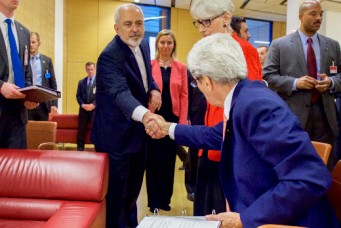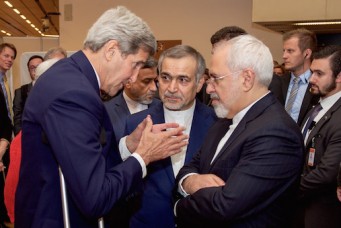In Vienna, U.S. and Iran Working to Beat the Clock
Thousands of miles away from the spin factories in Washington and Tehran, negotiators are working diligently to seal the deal. To hear the Europeans tell it, a deal is within reach.
“The Iran nuclear negotiations are on life support. Iranian officials are trying to leverage regional instability to win more favorable terms in a nuclear deal. Iran’s stubbornness has caused it to miss the last best chance at finalizing a nuclear deal by the November 24th deadline.” These are the latest arguments circulating in Washington, DC. The noise coming from Tehran about red lines is equally unhelpful. But here in Vienna, one can’t help but notice a stark difference between this rhetoric and reality.
Thousands of miles away from the spin factories in Washington and Tehran, negotiators are working diligently to seal the deal. To hear the Europeans tell it, a deal is within reach. “[Russian foreign minister] Lavrov was telling the truth. The deal is 95 percent done, but the remaining five percent is the most difficult details,” a Western diplomat told me. “When you see the various drafts of the agreement we’re putting together, it’s obvious we’ve come a long way—further than many thought possible. Relatively speaking, very little disputed language remains in brackets.”
As the negotiations reconvene, all eyes are on three unresolved issues. That’s right—only three. Numerous issues that have long been contentious—including Iran’s underground enrichment facility, its heavy water reactor, and inspections and monitoring, among others—have been largely hammered out. So what does that leave for negotiators to hash out?
The size and contours of Iran’s enrichment program under a comprehensive deal remains the most challenging point of contention. To date, Washington has insisted Tehran cut the number of its operational centrifuges to 1,500—down from 10,000. Not surprisingly, Iran rejects this push and prefers to keep its 10,000 operational centrifuges in return for a freeze on centrifuge expansion for the duration of a deal. The problem with these respective positions is that neither is firmly grounded in science. Instead, domestic politics have thus far dictated what the two sides insist upon at the negotiating table. This is not a recipe for success.
Centrifuge numbers are a dead end because they are largely arbitrary. It is more useful to focus on Separative Work Unit (SWU) count, which can vary even if centrifuge numbers remain constant. But even if SWU is used as the proper metric, bridging the gap will require compromise and creativity from both sides. Washington is insisting upon immediate-term limitations that prevent Tehran from enrichment levels that it cannot yet achieve. For its part, Iran is pushing for immediate-term enrichment levels that surpass its current needs.
Both sides must make the political decision to compromise and meet somewhere in the middle. It would be the biggest foreign policy blunder since the Iraq war to abandon a technically feasible nuclear deal for domestic political reasons. A good deal will cement Iran’s 2003 decision that nuclear weapons are not in its interest—and make it impossible for Iran to pursue nuclear weapons without being swiftly caught.
The U.S. and Iran also disagree over the duration of any comprehensive nuclear deal. It is worth noting both sides agree that Iran will adhere to limitations on its enrichment program for a mutually agreed upon period of time as a trust-building exercise. But after that period of time, Iran is free to act as any other member of the non-proliferation treaty. And therein lies the problem—precisely because the U.S. and Iran have trust issues, they disagree on how much time should pass before Tehran takes off the shackles.
Washington wants a deal to last for at least 20 years, while Tehran prefers three to five years—preferably while President Hassan Rowhani is still in office and can reap the domestic political benefits of ending the nuclear crisis. Accepting the other side’s terms would be political suicide for Iranian and American politicians. Again, both sides are using politics rather than science to dictate their respective positions. Decades of mistrust cannot be undone in three to five years—but 20 years of treating Iran differently that other NPT signatories fuels rather than allays Iranian suspicions of American intentions.
The duration of a comprehensive deal has become a political issue, so both sides must split the difference. There is no truly objective way to do this, so they should use the IAEA to provide scientific cover for a mutually agreed upon political decision. For example, Washington and Tehran should hammer out a timeline—10 years?—for permanently closing Iran’s nuclear file, take it to the IAEA, and have the agency announce the plan as an IAEA-led process. Doing so will give their political timeline for the duration of a deal the scientific veneer it needs to survive public scrutiny.
This will also help resolve the third remaining point of contention: Cooperation with the IAEA regarding Iran’s past nuclear activities—particularly possible military dimensions (PMD) prior to 2003. This is no doubt an important issue, but it is equally important to avoid making mountains out of molehills.
To hear Western diplomats tell it, one of the most interesting dynamics is the interplay between issues: If the two sides can agree on the size and contours of Iran’s enrichment program and the duration of a deal, PMD (and sanctions relief) issues should get resolved much easier. In other words, a political decision must be made in Washington and Tehran to accept technical solutions to these challenges—and it is easier to accept technical solutions when you know the political road ahead.
Ostensibly, Iran is negotiating with the P5+1 and the IAEA on separate tracks, but in reality, Iran’s cooperation with the IAEA is a direct function of the P5+1 track. Resolving PMD issues should be viewed through this lens. No amount of scrubbing sites or shifting soil can remove criminalizing traces of radiation, so the question is not if Iran answers PMD questions, but rather how. A potential win-win solution could be Iran accounting for past activities in return for ironclad P5+1 assurances that it will not pay for sins previously committed.
Washington and Tehran should accept this paradigm because focusing on a future that verifiably ensures the peaceful nature of Iran’s nuclear program is more important than shaming Tehran for activities it ceased over a decade ago. Consider the alternative: Without a comprehensive deal, Iran’s cooperation with the IAEA at best is reduced to pre-Rowhani levels. At worst, Iran-IAEA cooperation is dead. Iran’s nuclear program is the most heavily monitored in the world, and that is unlikely to remain the case without a comprehensive deal. Assertions to the contrary are less than honest.
As another Western diplomat told me: “If it was up to the negotiators, the deal would be done. It’s now up to political leaders on both sides to take yes for an answer.” Acknowledging the tremendous progress that has been achieved to date does not lessen the importance of the unresolved issues. But those issues need not torpedo a historic diplomatic victory. The common thread that runs through each of these issues is simple: political leaders in Washington and Tehran will need to show a greater willingness to absorb and sell compromise.
The reality facing both sides will not change: There are spoilers in the U.S. and Iran who will try to torpedo a deal, no matter the details. Precisely because it is impossible to satisfy ideologues, they only way to defeat them is to have a deal in hand that both sides believe is a win-win outcome. That will force the ideologues to publicly flesh out the details of their alternative—and the only alternative to a comprehensive deal is war. That is Obama and Rowhani’s trump card, and as November 24 approaches, they must play to win the game.
Reza Marashi is research director at the National Iranian-American Council. This article originally appeared in the Huffington Post.



